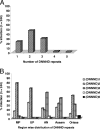Extensive genetic diversity in the Plasmodium falciparum Na+/H+ exchanger 1 transporter protein implicated in quinine resistance
- PMID: 17923493
- PMCID: PMC2167966
- DOI: 10.1128/AAC.00317-07
Extensive genetic diversity in the Plasmodium falciparum Na+/H+ exchanger 1 transporter protein implicated in quinine resistance
Abstract
The Plasmodium falciparum Na(+)/H(+) exchanger (Pfnhe-1) locus at chromosome 13 and another locus at chromosome 9 have recently been proposed to influence quinine resistance. Here, we sequenced the ms4760 locus of the Pfnhe-1 gene from 244 P. falciparum isolates collected from five different regions of India. A total of 16 different ms4760 alleles (with one to five DNNND repeats) were observed among these isolates. Interestingly, areas with a high prevalence of chloroquine and sulfadoxine-pyrimethamine resistance showed more Pfnhe-1 DNNND repeats compared to low drug resistance areas. The extent of genetic diversity at the ms4760 locus also varied from one region to another, with expected heterozygosity values ranging from 0.47 to 0.88.
Figures



References
-
- Ahmed, A., D. Bararia, S. Vinayak, M. Yameen, S. Biswas, V. Dev, A. Kumar, M. A. Ansari, and Y. D. Sharma. 2004. Plasmodium falciparum isolates in India exhibit a progressive increase in mutations associated with sulfadoxine-pyrimethamine resistance. Antimicrob. Agents Chemother. 48:879-889. - PMC - PubMed
-
- Ahmed, A., V. Lumb, M. K. Das, V. Dev, Wajihullah, and Y. D. Sharma. 2006. Prevalence of mutations associated with higher levels of sulfadoxine-pyrimethamine resistance in Plasmodium falciparum isolates from Car Nicobar Island and Assam, India. Antimicrob. Agents Chemother. 50:3934-3938. - PMC - PubMed
-
- Alam, M. T., H. Bora, P. K. Bharti, M. A. Saifi, M. K. Das, V. Dev, A. Kumar, N. Singh, A. P. Dash, B. Das, Wajihullah, and Y. D. Sharma. 2007. Similar trends of pyrimethamine resistance-associated mutations in Plasmodium vivax and P. falciparum. Antimicrob. Agents Chemother. 51:857-863. - PMC - PubMed
-
- Anderson, T. J., X. Z. Su, A. Roddam, and K. P. Day. 2000. Complex mutations in a high proportion of microsatellite loci from the protozoan parasite Plasmodium falciparum. Mol. Ecol. 9:1599-1608. - PubMed
Publication types
MeSH terms
Substances
Associated data
- Actions
- Actions
- Actions
- Actions
- Actions
- Actions
- Actions
- Actions
- Actions
- Actions
- Actions
- Actions
- Actions
- Actions
- Actions
- Actions
- Actions
- Actions
- Actions
- Actions
- Actions
- Actions
- Actions
- Actions
- Actions
- Actions
- Actions
LinkOut - more resources
Full Text Sources

